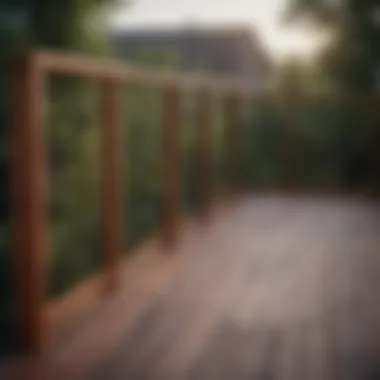Creative Outdoor Railing Ideas for Stunning Decks


Intro
Outdoor railings for decks serve as more than just safety barriers; they enhance the overall aesthetic appeal and functionality of your outdoor spaces. The right railing can unify design elements and provide a sense of completion to your decking area. This guide will explore various outdoor railing concepts, showcasing the latest trends, material choices, and practical considerations. Whether for leisure or social gatherings, a well-designed railing can elevate your deck experience.
Design Inspirations
Design inspirations for outdoor railings encompass a wide variety of styles and colors. These features allow homeowners to personalize their decks according to their preferences and harmonize with the surroundings.
Trending Styles
Some of the most popular railing styles today include:
- Modern Minimalist: Simple lines and clear materials like glass offer an unobstructed view, ideal for urban settings.
- Rustic Wood: This style embraces natural textures and colors, often using reclaimed wood to blend seamlessly with nature.
- Industrial Metal: Steel and aluminum railings lend a sleek, modern touch while providing durability. They’re often used in contemporary architecture.
Adopting unique features within these styles mar be beneficial. For example, pairing wood with metal accents creates contrast. Such combinations can make railings standout while also remaining functional.
Color Palettes
The colors selected for railings can significantly affect the overall ambiance:
- Neutral Tones: Whites, blacks, and grays offer versatility and can match nearly any decor.
- Earthy Hues: Browns and greens can help retain a natural aesthetic, blending with plants and landscapes.
- Bold Contrasts: Bright colors can serve as focal points. For instance, a bright red railing can make a dramatic statement against a neutral deck background.
Considering climate and surroundings is crucial when choosing colors. Lighter colors reflect heat and remain cooler, while darker shades can absorb more sunlight.
Functionality and Safety Considerations
When planning railings, safety cannot be neglected. Regulations typically require specific heights and spacing to prevent falls. It is essential to consult local building codes to ensure compliance. Beyond safety, think about how the railing style complements decking materials. Matching textures and colors enhance unity.
"The ideal outdoor railing should harmonize with the deck’s design while prioritizing safety and durability."
Maintenance and Upkeep
Caring for outdoor railings not only preserves their appearance but also ensures safety and longevity.
Seasonal Maintenance Checklist
Establish a seasonal maintenance routine. Here are tasks to consider:
- Inspect for loose fittings or damaged sections.
- Clean surfaces to remove dirt and grime.
- Treat wooden railings with sealants or stains as needed to prevent weather damage.
Maintaining metal railings may involve checking for rust or corrosion, applying protective coatings can be beneficial.
Cleaning and Organization Tips
Clean railings regularly, especially after storms or during seasonal changes. Use mild cleaning agents and soft brushes to avoid scratches. For wood railings, an annual treatment with wood preservatives ensures they withstand exposure to the elements.
Organize your outdoor space by considering storage solutions around the railing. This can improve usability during gatherings and offer a tidy appearance.
Intro to Deck Railings
Deck railings are an essential aspect of outdoor spaces, serving both functional and aesthetic purposes. They not only enhance the visual appeal of a deck but also provide a vital safety barrier. When designed and installed correctly, railings create a secure environment for family and guests. Moreover, they help in defining the space and making it more inviting. A well-chosen railing can improve the overall value of a property, reflecting the homeowner's style and attention to detail.
In this section, we will explore the importance of deck railings, the various types of decks, and their specific requirements. Each element plays a crucial role in how railings can be effectively integrated into the overall design of outdoor living spaces.
Importance of Deck Railings
Deck railings are not merely decorative; they play a critical role in safety. A comfortable and engaging outdoor area necessitates the presence of railings, particularly on raised decks where the risk of falling is a genuine concern. Railings provide security for children and pets, allowing them to enjoy the space without constant supervision. Furthermore, railings can enhance the structural integrity of the deck by acting as a supportive framework.


Having the right railings in place can also help comply with local building codes, which often dictate specific requirements for height and gap spacing. Beyond safety, the style of railings can also contribute to the aesthetic character of the deck, pairing seamlessly with other features such as furniture, landscaping, and home architecture.
Types of Decks and Their Requirements
Understanding the types of decks is fundamental in determining the best railing options. Different decks require distinct considerations for railings to ensure safety and appeal.
- Raised Decks: These typically need railings due to their height. The height and spacing of the rails must meet safety codes.
- Ground-Level Decks: While these may not require railings for safety reasons, they can still include them for aesthetic purposes. Railings can define the boundaries of the space and add character to the deck.
- Multi-Level Decks: These present unique challenges because they have varying heights. Thus, each level must have railings appropriate to their height, often creating a need for custom solutions.
- Pool Decks: Besides looking good, railings around pool decks must satisfy safety regulations, ensuring that access to the pool is controlled while maintaining visibility.
By considering the type of deck, homeowners can better select railings suitable for their specific requirements, balancing safety with style.
Material Choices for Deck Railings
The selection of materials for deck railings plays a vital role in both the aesthetic and functional performance of outdoor areas. Choosing the right material impacts not just the visual appeal but also the durability, safety, and maintenance needs of the structure. Each material offers unique characteristics, allowing homeowners to tailor their deck railings to meet specific style preferences and practical considerations. This section explores various material options, their benefits, and potential drawbacks to assist in making an informed choice.
Wood Railings
Types of Wood
Wood railings are a traditional choice, celebrated for their warmth and natural beauty. There are several types of wood available, such as cedar, redwood, and pressure-treated pine. Each type has its unique properties.
- Cedar: Naturally resistant to decay, cedar maintains its integrity over time. It also has an attractive aesthetic.
- Pressure-treated pine: This is a more economical option. It undergoes a chemical process to resist rot and insects.
Despite their beauty, wooden railings require regular maintenance, such as sealing and painting, to preserve their lifespan.
Cedar vs. Pressure-Treated Pine
Cedar is often preferred for its appearance and natural resistance to weather-related challenges. It does not warp easily and maintains color better than pressure-treated pine, which can dry out and crack. However, cedar is more expensive, making pressure-treated pine a popular alternative for budget-conscious homeowners. Both options require maintenance, but cedar demands less exposure to chemicals.
Maintenance Considerations
Wood railings need consistent maintenance to avoid decay. This includes regular inspections for signs of rot, insect damage, and mold. In addition, painting or staining is recommended every few years to keep the wood protected. Failing to maintain wooden railings can lead to costly repairs later on.
Metal Railings
Aluminum Features
Aluminum railings are growing in popularity due to their lightweight and durable characteristics. They do not rust like other metals, ensuring a longer lifespan with less maintenance. Aluminum can be finished in various colors, allowing for versatility in design. However, it can get hot in direct sunlight, which is a consideration in warmer climates.
Wrought Iron Durability
Wrought iron railings offer an unmatched level of durability. Known for their strength and stability, these railings can withstand significant weight and impacts, making them a safe choice. However, they require regular maintenance to prevent rust and corrosion, especially in humid environments.
Stainless Steel Aesthetics
Stainless steel railings provide a modern look with high corrosion resistance. Their sleek, shiny surface adds an element of sophistication that appeals to many homeowners. Despite their benefits, stainless steel can show fingerprints and smudges. Regular cleaning is essential to maintain their appearance.
Composite Railings
Sustainability Factor
Composite materials, made from a combination of wood fibers and plastic, offer a sustainable option. They reduce the need for natural wood and are often made from recycled materials. Their production has a lower environmental impact, making them an attractive choice for eco-conscious homeowners.
Color and Finish Options
One of the key features of composite railings is their vast array of colors and finishes. Homeowners can choose from various shades to fit their design vision, ensuring a unique and customized look. This flexibility is a significant advantage in contrasting the limited options typically offered with traditional wood.
Long-Term Performance
Composite railings are known for their durability and require minimal maintenance compared to wood. Their resistance to fading, scratching, and rotting makes them an excellent long-term investment. Although they might have a higher upfront cost than wood, their longevity can offset this expense over time.
Glass Railings
Transparency Benefits
Glass railings provide a breathtaking view and an open feel to any deck. By allowing unobstructed views of the landscape, they enhance the enjoyment of outdoor spaces. Their minimalist design contributes to modern aesthetics.
Safety Considerations
While glass railings enhance visibility, they must be installed with safety in mind. Tempered glass is recommended for its strength and safety. The installation should consider height regulations and the potential impact of environmental elements.
Cleaning and Upkeep
Glass railings require regular cleaning to maintain their clarity and appearance. Water spots and fingerprints can make them appear unsightly, so a simple cleaning routine is essential. Using appropriate glass cleaners ensures they retain their shine without scratching the surface.
Design Styles for Deck Railings
Design styles for deck railings play a crucial role in both the aesthetic and functional features of outdoor spaces. This section aims to highlight various styles that can enhance the visual appeal of a deck while ensuring safety and compliance with building regulations. Having a clear understanding of design styles helps homeowners make informed decisions tailored to their personal tastes and functional needs.
Modern Minimalist Approaches
Modern minimalism emphasizes simplicity and clean lines in railing design. It often favors the use of straight lines and uncluttered spaces. This approach creates an airy and open feel, allowing the landscape or architecture to take center stage.


Straight Lines and Clean Finishes
Straight lines and clean finishes are hallmarks of modern minimalist railings. Their significance lies in the visual clarity they provide. The key characteristic of this style is its straightforward design, which avoids intricate details. Homeowners appreciate this choice for its contemporary vibe. Unique to this option is its ability to blend seamlessly with various deck materials, ensuring overall cohesion. While the advantages include ease of maintenance and a timeless appeal, one potential disadvantage is that it might not suit traditional home styles, thus limiting its versatility.
Use of Neutral Colors
Using neutral colors is another defining feature of modern minimalist railings. Neutral tones like white, gray, or beige create a soft background that complements various architectural elements. This characteristic enhances flexibility and ensures the railings do not overpower the view. For many, these colors are widely regarded as stylish and sophisticated. One unique feature is how they enhance natural light, making spaces appear larger and more inviting. However, the downside could be that overly muted palettes may lack personality, making personalization tricky for some homeowners.
Blending with Nature
Blending with nature focuses on creating a visual connection between the deck and the surrounding environment. This characteristic is essential for homeowners who seek to enhance their outdoor experience. The approach often includes the use of natural materials or colors that mimic the hues found in nature. It allows the railing to become a subtle extension of the landscape rather than a distraction. One unique feature is how it promotes a tranquil and cohesive look that encourages relaxation. However, a potential disadvantage could be that such designs may require careful planning to ensure proper integration with existing outdoor elements.
Traditional and Rustic Designs
Traditional and rustic designs bring the warmth of classic aesthetics to outdoor spaces. These styles often incorporate elements that evoke a sense of nostalgia, appealing to homeowners who cherish timeless charm.
Classic Wood Bans
Classic wood bans offer a traditional look that many homeowners find comforting. The key characteristic here is the use of wood, which not only provides durability but also a natural beauty. This option is widely appreciated for its warmth and ability to blend harmoniously with outdoor surroundings. A unique feature of classic wood is its versatility in design, allowing for various styles, from arched tops to decorative finials. On the downside, wood requires regular maintenance to prevent decay, which can be a considerable commitment.
Decorative Metal Elements
Decorative metal elements add an artistic touch to traditional railings. The characteristic that stands out is the incorporation of detailed designs, such as scrollwork. This makes railings not just functional barriers but also decorative features. Homeowners often choose this style for its ability to infuse a sense of elegance into outdoor spaces. A unique advantage is the strength of metal, which often outlasts wood. Nevertheless, decorative elements can sometimes feel overly ornate, which may not align with all design preferences.
Vintage Detailing
Vintage detailing refers to the intricate craftsmanship found in traditional designs. The significance is in its ability to evoke memories of bygone eras, appealing to those who appreciate history in their home design. The key characteristic of this style is its ornate features, such as turned balusters and brackets. This choice is popular for its unique charm and character. A unique benefit of vintage detailing is how it can become a conversation piece for guests. On the flip side, these railings may require more frequent upkeep and are sometimes less practical in modern contexts.
Contemporary Designs
Contemporary designs break the mold by incorporating innovative shapes and materials. This style is well-suited for those wanting to express their individuality and make a bold statement in their outdoor area.
Bold Color Choices
Bold color choices are pivotal in contemporary designs, allowing homeowners to infuse their personalities into their railings. The key characteristic is the use of striking shades that catch the eye. This style is appealing to those who want to create a lively atmosphere and stand out. A unique feature is the variety of finishes available, from matte to gloss, making color application even more dynamic. However, the downside may be the potential for colors to clash with existing decor.
Geometric Shapes
Geometric shapes bring a modern edge to railing designs. This characteristic focuses on sharp angles and distinctive patterns that draw attention. Homeowners may find this style beneficial for its innovative approach, adding uniqueness to their deck's profile. A unique aspect is the versatility in design—these shapes can often be mixed and matched to create custom looks. One disadvantage could be the complexity of installation, as precise measurements are necessary for a polished finish.
Mixed Materials
Mixed materials incorporate various elements, such as wood, glass, and metal, into a single railing design. The key feature of this style is its ability to combine the strengths of each material for both aesthetic and functional purposes. This design is popular because of its adaptability—homeowners can create a unique look that specifically fits their vision. Unique features include increased durability and the potential for creating interesting contrasts. However, one downside might be the higher costs associated with sourcing multiple materials.
Functional Considerations
Understanding functional considerations is crucial when selecting railings for your deck. These factors not only ensure safety and compliance with laws but also enhance the usability and aesthetics of your outdoor space. Key aspects such as building codes, safety features, and the practical functionality of the railings need to be carefully evaluated.
Building Codes and Regulations
Height Requirements
Height requirements determine how tall railings should be for safety and design standards. Generally, the minimum height for deck railings is around 36 inches for residential decks and 42 inches for commercial spaces. This height is beneficial as it prevents accidental falls, especially from elevated surfaces. Consistency in these measurements helps homeowners understand what is necessary for safe deck usage. Unique to height requirements, local regulations may dictate specific measurements, meaning it is handy to double-check these standards in your area.
Load-Bearing Capacity
Load-bearing capacity refers to the weight that the railing can structurally support without compromising stability. This aspect is fundamental in promoting safety and longevity in railing design. Railings must withstand the forces from people leaning on them or even from the weight of snow in colder climates. A beneficial characteristic of strong load-bearing railings is their reliability over time, which makes them a wise choice for deck safety. However, inadequate load capacity can lead to severe consequences and thus should be carefully considered during installation.


Local Compliance
Local compliance is about meeting specific regulations that jurisdictions impose on outdoor railings. This ensures safety and adherence to public safety standards. Compliance reflects community standards and can enhance property value. Successfully meeting compliance often requires understanding building codes specific to your locality. A unique feature of local compliance is the chance for continuous updates and amendments, meaning staying informed is essential for deck owners.
Safety Features of Railings
Height and Spacing Guidelines
Height and spacing guidelines are critical for ensuring that railings are both secure and functional. Proper spacing prevents children or pets from slipping through the gaps, a vital consideration for safety. These guidelines usually dictate that vertical balusters should be spaced no more than 4 inches apart. A key characteristic of adhering to these standards is preventing accidents, making it popular among families. However, overly restrictive spacing may impact the visual aesthetic, requiring a balance between safety and design.
Non-Slip Surfaces
Non-slip surfaces on railings enhance safety, particularly in wet conditions or during bad weather. These surfaces are designed with materials that offer better grip, reducing the chances of slips and falls. Their essential function is to provide peace of mind for users, especially when children are present. A common disadvantage, however, is that they may require more maintenance than traditional surfaces, as they can accumulate dirt more readily over time.
Child Safety Considerations
Child safety considerations are paramount for any household with young ones. This includes ensuring that railings are built high enough, that there are no sharp edges, and that the spaces between railings are small enough. It is beneficial to have railings that include features such as secure locking mechanisms to ensure children cannot tamper with them. One unique feature of these considerations is installing netting or screens to provide additional protection without compromising visibility. The challenges include potentially increased costs and design changes that might not align with all homeowners' aesthetic preferences.
Customization Options
Customization options are crucial in achieving a personalized touch for outdoor railings. They allow homeowners to reflect their style while considering aesthetic and functional needs. By leveraging various elements, you can ensure the railing not only complements the deck but also enhances the overall outdoor experience. It is essential to explore these elements, as they can significantly affect the ambiance and usability of your space.
Color and Finish Selection
Selecting the right color and finish is a key step in customizing outdoor railings. The choice of color impacts how the railing interacts with the deck and surrounding environment. A well-matched color can help create a cohesive look. On the other hand, contrasting colors may create a striking effect, drawing the eye to the detail in design. Consideration should be given to finishes as well. Matte finishes may offer a subtle look, while gloss finishes can give a more refined touch. Care must be taken to choose colors that withstand outdoor conditions without fading or deteriorating over time.
Incorporating Lighting Systems
Types of Lighting
The type of lighting system you choose is important for your outdoor railing design. LED lights are a popular choice due to their efficiency and long lifespan. They can be integrated along the railing's edges or placed within post caps. This type of lighting offers a modern look and is energy-efficient, contributing to overall cost savings. The unique feature of LED lighting is its ability to provide both functional and ambient illumination. However, one drawback may be the initial installation costs compared to traditional lighting options.
Placement Considerations
Placement of lights in the railing design must be thoughtfully considered. Properly placed lights enhance safety by illuminating steps and transitions. It also influences the visual appeal at night. Strategically placed fixtures can highlight architectural features of the deck and create inviting pathways. One potential downside is that improper placement can lead to shadows, reducing effectiveness. Thus, planning the placement ahead of time is crucial to achieving desired effects.
Ambient Lighting Effects
Ambient lighting creates a warm and welcoming atmosphere that can transform an outdoor space. When using railing lights, this type of lighting can fill the area with a soft glow, allowing enjoyment at night. The key characteristic of ambient lighting is its ability to blend into the background, enhancing without overwhelming. It is a beneficial choice for social gatherings or quiet evenings. The main disadvantage can be the insufficient light for specific tasks, like reading, requiring additional lighting sources nearby.
Accessory Additions
Planters
Incorporating planters into the railing design adds a touch of nature and color to the outdoor space. Planters can be attached directly to the railing, providing visual interest and a vibrant environment. This is a popular choice for those looking to integrate greenery into their decor. The unique feature of planters is their ability to introduce seasonal changes to the look of the deck. However, the challenge is ensuring proper drainage, which is critical for plant health, thus requiring regular maintenance.
Seating Options
Adding seating options to deck railings provides functionality as well as style. Built-in seating solutions can maximize space while offering a practical place for relaxation. The choice of materials for seating should align with the overall railing design. Durable and weather-resistant materials are ideal, ensuring longevity. A unique feature of in-built seating is the comfort and accessibility it offers. However, it can also limit flexibility in rearranging the deck layout.
Storage Solutions
Storage solutions can be integrated seamlessly with railings to enhance outdoor functionality. Weatherproof storage boxes can keep cushions or tools safe and organized. This addition is particularly beneficial in smaller outdoor spaces where maximizing every inch is crucial. The main advantage is decluttering the deck, creating a more appealing environment. A potential downside may be the need for careful selection of materials to ensure they match the railings aesthetically, providing a cohesive look.
Epilogue
Summary of Key Points
It's essential to revisit the core ideas presented in the article. We examined various materials suitable for railings, including wood, metal, composite, and glass. Each material has its unique benefits and drawbacks, impacting choice based on individual needs and preferences. Design styles were also highlighted, ranging from modern minimalist to rustic designs, demonstrating the diversity available. Functional considerations, including compliance with building codes and safety features, were integral to ensuring the selected railings offer adequate security. Customization options, including color selection, lighting, and accessories, can elevate outdoor decks, making them more inviting and personalized.
Final Thoughts on Outdoor Railings
In summary, selecting the right outdoor railing is more than a design choice. It involves careful consideration of safety, material durability, and overall style coherence with the home. Homeowners are encouraged to embrace creativity in their selections, balancing personal taste with functional requirements. Investing time in understanding various options available can greatly enhance the enjoyment derived from outdoor spaces. By doing so, one can transform a simple deck area into a stylish and safe outdoor retreat.







